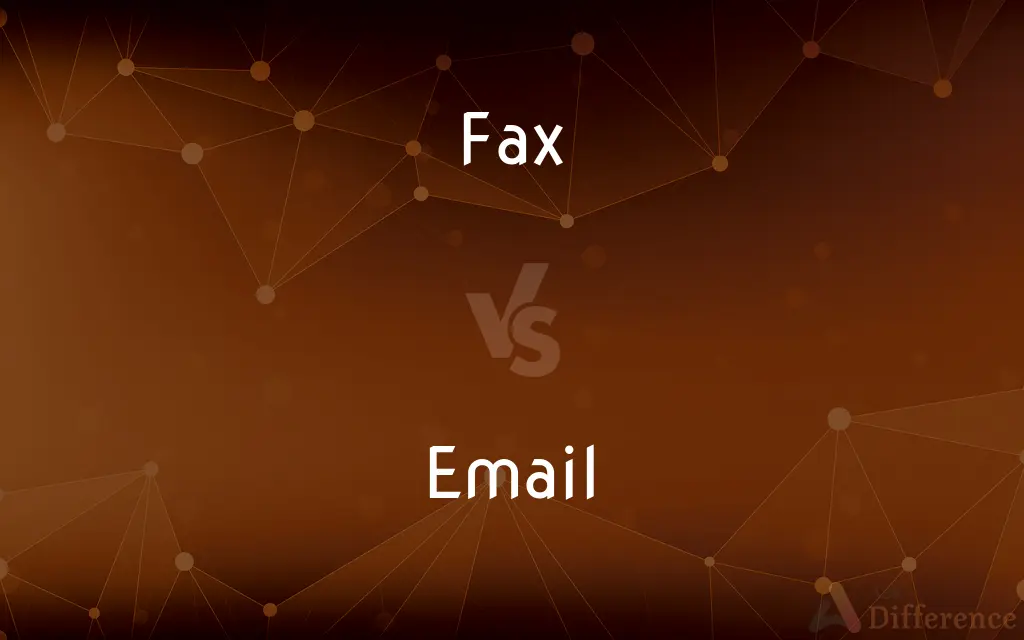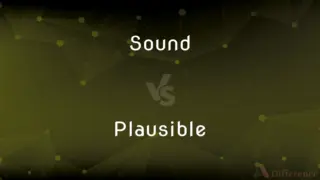Fax vs. Email — What's the Difference?
By Tayyaba Rehman & Fiza Rafique — Updated on March 27, 2024
Fax transmits scanned documents via phone lines, ideal for legal documents, while email sends digital data over the internet, faster and more versatile.

Difference Between Fax and Email
Table of Contents
ADVERTISEMENT
Key Differences
Fax, or facsimile, involves the transmission of scanned printed material (both text and images) via the telephone network, traditionally used for sharing documents that need signatures or contain sensitive information. On the other hand, email (electronic mail) sends messages and digital documents over the internet, allowing for quick communication and the sharing of a wide range of digital files.
While fax machines scan and transmit documents as bitmaps, making them more suitable for sending specific types of documents like signed contracts or official records, email allows for the attachment of files in various formats, including text, images, and multimedia, enhancing versatility in communication. This difference highlights fax's role in formal transactions and email's adaptability for both formal and informal exchanges.
The process of faxing can be slower, as it involves the transmission of data over phone lines, which can take minutes for a single document, depending on its length and complexity. Email, however, can deliver messages and attached files almost instantaneously to recipients anywhere in the world with internet access, reflecting its efficiency and global reach.
Security and privacy concerns also differ between the two; faxes are often considered more secure for transmitting sensitive information, as intercepting a fax requires access to the phone line. Conversely, emails can be more vulnerable to interception and hacking, although encryption technologies have significantly improved email security.
In terms of record-keeping and accessibility, faxes require physical storage or digital archiving if converted to electronic format, which can be cumbersome. Emails and their attachments, however, can be easily stored, searched, and retrieved from digital archives, offering superior convenience and organization.
ADVERTISEMENT
Comparison Chart
Transmission
Via telephone lines, scanning and sending documents as bitmaps.
Over the internet, sending messages and files in various formats.
Suitability
Ideal for legal documents, contracts, and sensitive information.
Versatile, suitable for a wide range of communication needs.
Speed
Slower, depends on document length and phone line quality.
Instantaneous, global delivery with internet access.
Security
Considered secure due to difficulty of intercepting phone lines.
Potentially vulnerable but improved with encryption.
Document Format
Primarily scanned images and texts.
Supports text, images, multimedia, and various file types.
Storage
Requires physical or digital archiving.
Easily archived, searched, and retrieved digitally.
Compare with Definitions
Fax
Can be slower and less convenient than digital methods.
Sending the multi-page document via fax took several minutes.
Sends digital messages and attachments via the internet.
She emailed the report to her team for review.
Fax
Often used for legal documents and situations requiring signatures.
Legal offices frequently use fax for document exchange.
Widely used for both formal and informal communication.
Emails are used daily for a variety of personal and professional tasks.
Fax
Transmits documents via analog signals over telephone lines.
The contract was faxed to ensure it arrived securely.
Provides almost instantaneous delivery.
The confirmation email arrived within seconds.
Fax
Considered secure for sensitive information.
Confidential medical records were sent via fax to maintain privacy.
Enhanced security with modern encryption standards.
Secure email services encrypt messages to protect against hacking.
Fax
Requires a physical machine or dedicated software.
The office maintains a fax machine for official correspondence.
Easily organized and archived for future reference.
He archived the project emails for easy retrieval.
Fax
Fax (short for facsimile), sometimes called telecopying or telefax (the latter short for telefacsimile), is the telephonic transmission of scanned printed material (both text and images), normally to a telephone number connected to a printer or other output device. The original document is scanned with a fax machine (or a telecopier), which processes the contents (text or images) as a single fixed graphic image, converting it into a bitmap, and then transmitting it through the telephone system in the form of audio-frequency tones.
Electronic mail (email or e-mail) is a method of exchanging messages ("mail") between people using electronic devices. Email entered limited use in the 1960s, but users could only send to users of the same computer.
Fax
A fax machine.
Messages distributed by electronic means from one computer user to one or more recipients via a network
Reading email has become the first task of the morning
Email messages
Fax
A document transmitted or received by a fax machine. In both senses also called facsimile.
Send an email to (someone)
You can email me at my normal address
Call, fax, or email for a free demo
Fax
To transmit (a document) by a fax machine.
A system for sending and receiving messages electronically over a computer network.
Fax
The hair of the head.
A message or messages sent or received by such a system.
Fax
Senseid|en|machine}} {{ellipsis of fax machine
To send (someone) an email
I'll email you when I know my schedule.
Fax
A document sent, or received and printed by a fax machine
To send (a message) by email.
Fax
To send a document via a fax machine.
(uncountable) A system for transferring messages from one computer to another, usually through a network.
Snail mail
He sent me his details via email.
The advent of email has simultaneously brought our society closer together and farther apart.
Fax
Alt form of facts.
(uncountable) A quantity of messages sent through an email system.
I am searching through my old email.
My inbox used to allow only 50 MB of email at a time until last year, when they upgraded it to 2 GBs!
Fax
Duplicator that transmits the copy by wire or radio
(countable) A message sent through an email system.
He sent me an email last week to remind me about the meeting.
I archive my old emails using a cloud-based service.
Fax
Send something via a facsimile machine;
Can you fax me the report right away?
An email address.
What’s your email?
Don’t send personal messages to my work email.
(transitive) To send an email or emails to.
She emailed me last week, asking about the status of the project.
To send (something) through email.
I’ll email you the link.
He emailed the file out to everyone.
(intransitive) To send, or compose and send, an email or emails.
Most teenagers seem to spend almost the whole day emailing and surfing the Web.
(computer science) a system of world-wide electronic communication in which a computer user can compose a message at one terminal that is generated at the recipient's terminal when he logs in
Communicate electronically on the computer;
She e-mailed me the good news
Common Curiosities
What is fax used for?
Fax is used for transmitting scanned documents, especially legal ones requiring signatures, via phone lines.
How does email differ from fax in terms of speed?
Email is faster, delivering messages and files almost instantly worldwide, unlike fax, which can be slower.
Can emails serve the same legal purposes as faxes?
Yes, with the advent of digital signatures, emails can serve similar legal purposes as faxes, though some industries still prefer fax for certain documents.
Are there any legal documents that cannot be sent via email?
While most documents can be sent via email, some jurisdictions or institutions may require original signatures or notarized documents to be faxed or mailed.
Why might fax be considered more secure than email?
Faxes are transmitted over phone lines, making interception more difficult, whereas emails can be more easily intercepted or hacked.
How do companies manage sensitive information when using email?
Companies use encryption, secure email platforms, and policies on data protection to manage sensitive information via email.
How do fax and email compare in terms of environmental impact?
Email is generally more environmentally friendly, reducing the need for paper and ink used by fax machines.
How has the use of fax changed with the advent of email?
Fax use has declined in many areas but remains prevalent in sectors like law, healthcare, and real estate, where document security is paramount.
Can emails be legally binding?
Yes, emails can be legally binding, especially when used with digital signatures and in jurisdictions that recognize electronic documents.
Is faxing completely obsolete?
While its use has declined, faxing is not completely obsolete and is still used in specific industries for secure document transmission.
What is needed to send a fax compared to an email?
Sending a fax requires a fax machine or dedicated software and a phone line, while email requires an internet connection and an email account.
Can fax machines send messages to email addresses?
Yes, through fax-to-email services, faxes can be sent directly to an email address as a digital file.
What are the main advantages of email over fax?
Email offers speed, versatility, and the ability to easily store and organize digital correspondence.
How do recipients receive faxes as opposed to emails?
Recipients receive faxes through a fax machine or fax-to-email service, whereas emails arrive in the recipient's email inbox.
What technologies have emerged to replace fax?
Digital document management systems, secure email, and cloud services are among the technologies that have emerged to replace fax.
Share Your Discovery

Previous Comparison
Stickball vs. Baseball
Next Comparison
Sound vs. PlausibleAuthor Spotlight
Written by
Tayyaba RehmanTayyaba Rehman is a distinguished writer, currently serving as a primary contributor to askdifference.com. As a researcher in semantics and etymology, Tayyaba's passion for the complexity of languages and their distinctions has found a perfect home on the platform. Tayyaba delves into the intricacies of language, distinguishing between commonly confused words and phrases, thereby providing clarity for readers worldwide.
Co-written by
Fiza RafiqueFiza Rafique is a skilled content writer at AskDifference.com, where she meticulously refines and enhances written pieces. Drawing from her vast editorial expertise, Fiza ensures clarity, accuracy, and precision in every article. Passionate about language, she continually seeks to elevate the quality of content for readers worldwide.















































